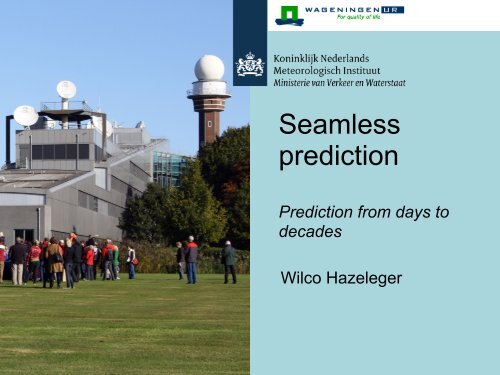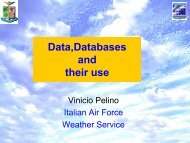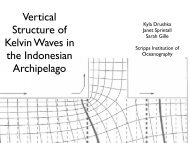Seamless prediction
Seamless prediction
Seamless prediction
Create successful ePaper yourself
Turn your PDF publications into a flip-book with our unique Google optimized e-Paper software.
<strong>Seamless</strong><br />
<strong>prediction</strong><br />
Prediction from days to<br />
decades<br />
Wilco Hazeleger
<strong>Seamless</strong> <strong>prediction</strong>
<strong>Seamless</strong> <strong>prediction</strong>
<strong>Seamless</strong> <strong>prediction</strong><br />
The science case:<br />
Same physical principles for weather and climate (but different<br />
processes acting on different scales)<br />
Prediction problem with different role initial and boundary conditions<br />
Seasonal to decadal <strong>prediction</strong> as focus<br />
The modelling case:<br />
Convergence of NWP-Climate model development<br />
<strong>Seamless</strong> earth system <strong>prediction</strong><br />
The application case:<br />
Calibration (weights) of climate <strong>prediction</strong>s & projections<br />
<strong>Seamless</strong> connection to impact studies
3 pillars of 21st century scientific method<br />
Theory (since antiquity)<br />
Combined with experiment<br />
(since Galilei & Newton)<br />
….and with simulation<br />
(since 1940s, Teller, von Neumann, Fermi,..)
Sources and limits of<br />
predictability
Natural variability, chaotic atmosphere<br />
Lorentz limit ~15 days<br />
Selten et al, Sterl et al 2008
Natural and `forced variability
Predicting natural variability: more than noise?<br />
• 0-hypothesis: ocean integrates white noise (weather)<br />
(Hasselmann 1976)<br />
dX ( t)<br />
dt<br />
= −α X ( t)<br />
+ζ ( t)<br />
• With α damping coefficent and ζ(t) random variable (AR1 process à red noise)<br />
• When variability stands out of red noise, e.g. oscillations due<br />
to internal dynamics, dynamical <strong>prediction</strong>s may be possible<br />
• But… even red noise is a source of predictability (e.g. damped<br />
persistence)
Spectra of global mean temperature: peaks?
Monthly: Soil moisture, Sea Surface temperatures,<br />
Atmospheric composition<br />
l Dry soils in spring can lead to high summer temperatures
Seasonal to interannual: El Niño<br />
Sea surface temperature anomaly during El Niño
Seasonal to interannual: Coupled ocean-atmosphere<br />
variability
El Nino – Southern Oscillation (ENSO)<br />
" Predictable 3-9 month ahead (depending on the season)<br />
" World-wide impact<br />
Precipitation SON<br />
Temperature DJF
Decadal: Atlantic Multidecadal Oscillation<br />
Knight et al. 2005
Decadel: Pacific decadal variability
Multi-decadal: anthropogenically forced change
Modelling climate changes: uncertainties<br />
Natural<br />
fluctuations<br />
GHG emission<br />
uncertainty<br />
Model uncertainty<br />
Hawkins and Sutton, 2009
Predictability beyond the Lorentz-limiet<br />
l<br />
The atmospheric circulation is chaotic and unpredictable beyond<br />
~15 days, the averaged weather is in some areas and in some<br />
seasons predictable beyond the Lorentz limit<br />
l<br />
l<br />
(damped) persistence beyond 15 days<br />
Showly fluctuating patterns of variability (often involving slow<br />
ocean responses): ENSO, Indian Ocean Zonal Mode, Pacific<br />
Decadal Oscillation, Atlantic Multidecadal Oscillation,…,…<br />
l<br />
Initial conditions of the earth system provide memory: ocean,<br />
ice, soil, atmospheric composition<br />
l<br />
Anthropogenic forcing (trends) predictable
The ideal case: potential<br />
predictability
What to expect from <strong>prediction</strong>s?<br />
• Diagnostic potential predictability: ratio of variances in a long<br />
control simulation<br />
DPP<br />
=<br />
σ<br />
σ<br />
m<br />
2<br />
σ<br />
2 − 1<br />
v<br />
2<br />
• With σ v<br />
2<br />
variance of m-year means<br />
(e.g. Boer et al, Pohlmann et al)
Diagnostic potential predictability in EC-Earth<br />
10 yr
What to expect from <strong>prediction</strong>s?<br />
• Prognostic potential predictability: ensemble spread in relation<br />
to total variance<br />
PPP = 1−<br />
1<br />
N(<br />
M<br />
−1)<br />
i=<br />
1<br />
2<br />
• With X ij is the i th member of j th ensemble, N is number<br />
ensembles, M number of ensemble members<br />
N<br />
∑<br />
j=<br />
1<br />
M<br />
∑<br />
σ<br />
[ X<br />
ij<br />
( t)<br />
− X<br />
j<br />
( t)]<br />
2<br />
Griffies and Bryan 1997, Collins et al, Pohlmann et al
Atlantic MOC (30N)<br />
MOC (Sv)<br />
Collins et al 2006
Prognostic Potential predictability in EC-Earth (T2m, yr<br />
1-10)<br />
T. Koenigk, SMHI, pers. comm.
Prognostic potential predictability in EC-Earth (T2m, yr<br />
1-10; without trend)<br />
T. Koenigk, SMHI, pers. comm.
Making <strong>prediction</strong>s
Prediction systems<br />
l<br />
Statistical<br />
l<br />
l<br />
l<br />
l<br />
analyse 100 years of data for relationships<br />
Easy to fool yourself (and others)<br />
Much used in tropics: Monsoons India, Indonesia, West Africa,<br />
hurricanes, seasonal <strong>prediction</strong> US<br />
Often misused: summer and winter <strong>prediction</strong>s for Europe
Statistical: Precipipation in Curaçao<br />
l<br />
Rain related to ENSO<br />
4 months in advance
Prediction systems<br />
l Dynamical<br />
Use numerical weather <strong>prediction</strong> model, run it longer. Use climate<br />
model, run it shorter<br />
" Essential: good initial state of ocean, snow, soil, aerosols,<br />
greenhouse gasses<br />
" ECMWF, EC-Earth, Met Office, Météo France, NCEP, ...
Prediction experiment<br />
Initialize atmosphere-ocean-sea ice-land models<br />
from observed/analyzed ocean and sea ice state<br />
Perturb initialized models to generate ensembles<br />
Verify the results against own analyses and<br />
independent observations
Complex Global Circulation Model<br />
Based on laws of physics (F= m x a<br />
and thermodynamics)<br />
Forcing specified (Q= e.g. radiation)<br />
Small scales not resolved<br />
Big science: 2 million lines of code<br />
and 10 variables on 10^9 gridpoints
Initialization, in particular the ocean:<br />
Limited subsurface ocean observations<br />
1960 1980<br />
2007
Initialisation ocean: ocean analyses<br />
A. Koehl, pers. comm.
Perturbing the ensemble<br />
" Perturbations which grow most rapidly in slow component (e.g. in<br />
ocean, for instance Kleeman et al. for ENSO, Hawkins and Sutton<br />
for 3D ocean, bred vectors B. Kirtman etc.)<br />
" Consistent with the observational uncertainties<br />
" Can be useful for identifying regions where additional observations<br />
would be most valuable to improve <strong>prediction</strong>s
Perturbing ocean<br />
• E.g. linear Inverse Modelling (Penland & Sardeshmukh 1995, Hawkins &<br />
Sutton 2009)<br />
dx<br />
dt<br />
x(<br />
t<br />
P<br />
T<br />
= Bx + ζ x represents<br />
+ τ ) =<br />
Px<br />
0<br />
= λx<br />
P x(<br />
t)<br />
τ<br />
0<br />
leading EOFs<br />
Eigenvectors are<br />
optimal growing<br />
perturbations<br />
In practice, pragmatic approaches (perturbing<br />
atmosphere, different ocean states, perturbing ocean<br />
diffusivity)<br />
Hawkins & Sutton 2009
Measures of skill
Measures of skill
Some simple deterministic measures of skill<br />
N<br />
• Mean error (additive<br />
1<br />
bias)<br />
ME = ∑(<br />
Fi<br />
− O<br />
N<br />
i=<br />
1<br />
i<br />
)<br />
• Root mean square error<br />
RMSE<br />
=<br />
1<br />
N<br />
N<br />
∑<br />
i=<br />
1<br />
(<br />
−<br />
F i Oi<br />
)<br />
2<br />
• Anomaly correlation<br />
• (F=forecast,<br />
=observation,<br />
C=climatology)<br />
AC<br />
( F −C)(<br />
O −C)<br />
= ∑<br />
2<br />
( F −C)<br />
( O −C)<br />
2
Skill weather <strong>prediction</strong>: 500hPa height
Skill dynamical seasonal <strong>prediction</strong>s: temperature<br />
Dec-Feb temperature, predicted from 1st of November<br />
Note: bias correction always needed
Skill dynamical seasonal <strong>prediction</strong>s: precipitation
Probabilistic scores<br />
Reliability diagram: How well do the predicted probabilities of an<br />
event correspond to their observed frequencies?<br />
The range of forecast probabilities is divided into K bins (for example, 0-5%, 5-15%, 15-25%, etc.).<br />
The sample size in each bin is often included as a histogram or values beside the data points.
Skill single and multi-model ensemble<br />
From EU Demeter project (Doblas Reyes)
Probabilistic score<br />
Relative Operation Characteristic: What is the ability of the forecast<br />
to discriminate between events and non-events?<br />
Plot hit rate (POD) vs false alarm rate (POFD), using a set of increasing probability thresholds<br />
(for example, 0.05, 0.15, 0.25, etc.) to make the yes/no decision.<br />
The area under the ROC curve is frequently used as a score.
Temperature<br />
Precipitation
ROC score, 3 month lead time<br />
Temperature<br />
Sea level pressure
Probabilistic scores<br />
Rank histogram: How well does the ensemble spread of the forecast<br />
represent the true variability (uncertainty) of the observations?<br />
1. At every observation (or analysis) point rank the N ensemble members from lowest to highest.<br />
2. Identify which bin the observation falls into at each point<br />
3. Tally over many observations to create a histogram of rank.<br />
Flat - ensemble spread about right to represent forecast uncertainty<br />
U-shaped - ensemble spread too small, many observations falling outside the extremes of the<br />
ensemble<br />
Dome-shaped - ensemble spread too large, most observations falling near the center of the ensemble<br />
Asymmetric - ensemble contains bias
Always use a 0-hypothesis<br />
• Verify against<br />
simplest statistical<br />
X ( t + τ )<br />
model (AR1,<br />
damped persistence, A(<br />
τ ) = 0<br />
or climatology) A(<br />
τ ) = 1<br />
=<br />
A(<br />
τ ) X ( t)<br />
(climatology)<br />
(persistence)
Skill dynamische verwachtingen<br />
l<br />
l<br />
l<br />
l<br />
Temperatuur: trend + persistentie + ENSO<br />
Neerslag: ENSO + beetje meer, beter dan puur statistische<br />
modellen<br />
Kan regionaal verbeterd worden met downscaling technieken (bv<br />
SVD tussen waargenomen en verwachte velden om spatiële biases<br />
te corrigeren)<br />
Zal beter worden naarmate meer relevante processen goed<br />
gecalibreerd maagenomen worden.
The model and bias
Based on ECMWF weather<br />
and seasonal <strong>prediction</strong><br />
system<br />
Regular merging with<br />
operational ECMWF<br />
NWP system<br />
Resolution standard runs:<br />
Atmosphere: T159 L62<br />
(AMIP runs up to T799)<br />
Hazeleger et al BAMS, October, 2010<br />
Ocean: 1 degree L42 (with<br />
equatorial refinement<br />
and tripolar grid)
Low (T159) and high resolution (T799)
EC-Earth: temperature and bias
EC-Earth: precipitation and bias
EC-Earth: El Nino
EC-Earth: the North Atlantic Oscillation<br />
Observations<br />
EC-Earth
EC-Earth: the Atlantic Ocean overturning
EC-Earth: global mean temperature<br />
EC-Earth<br />
Observations
‘Weather’ <strong>prediction</strong>s
Seasonal <strong>prediction</strong>s
Seasonal <strong>prediction</strong>s: mean bias<br />
May<br />
Nov<br />
Bias of first month near-surface air temperature re-forecasts wrt ERA40/Int over 1976-2005.
Seasonal <strong>prediction</strong>s: ENSO (2-4 month lead time)<br />
EC-Earth<br />
Ratio sd: 1.34<br />
Corr: 0.82<br />
RPSSd: 0.48<br />
ECMWF System 3<br />
Ratio sd: 0.84<br />
Corr: 0.86<br />
RPSSd: 0.68<br />
Niño3.4 time series for ERA40/Int (red dots), ensemble range (green box-and-whisker)<br />
and ensemble mean (blue dots) 2-4 month (JJA) re-forecasts over 1981-2005.<br />
Doblas-Reyes, IC3-group
Correlation skill<br />
1-month<br />
lead time<br />
JJA<br />
DJF<br />
7-month<br />
lead time<br />
Ensemble-mean correlation of EC-Earth near-surface air temperature re-forecasts<br />
wrt ERA40/Int over 1976-2005. Dots for values statistically significant with 95% conf.
Seasonal forecast ENSO
Seasonal forecast July-Sept 2011 temperature<br />
Left: <strong>prediction</strong>; anomalies probability above mean<br />
Right: ROC skill (hit rate vs false alarm rate)
Seasonal <strong>prediction</strong>s: tropical cyclones
Decadal <strong>prediction</strong>s
Decadal <strong>prediction</strong>s in EC-Earth: global mean SST<br />
Wouters et al, in prep
Decadal <strong>prediction</strong>s in EC-Earth, drift corrected<br />
Wouters et al, in prep
Verification multi-model EU-ENSEMBLES decadal<br />
<strong>prediction</strong>s<br />
van Oldenborgh, Doblas-Reyes, Wouters and Hazeleger, subm
Skill multiannual <strong>prediction</strong>s<br />
anomaly correlations ensemble mean – observations<br />
lead time 2-5 years and 6-9 years averaged
Verification multi-model decadal <strong>prediction</strong>s<br />
van Oldenborgh, Doblas-Reyes, Wouters and Hazeleger, subm
Skill initialized <strong>prediction</strong>s at multiannual lead times<br />
• Trend, as defined by regression on global mean CO 2 concentrations,<br />
removed<br />
• Seasonal predictability comparable to ECMWF S3
Skill initialized <strong>prediction</strong>s at multiannual lead times<br />
R=0.77 R=0.80 R=0.19
Skill initialized <strong>prediction</strong>s at multiannual lead times<br />
• Trend, as defined by regression on global mean CO 2 concentrations,<br />
removed<br />
• Seasonal predictability comparable to ECMWF S3
Predicting Atlantic Multidecadal Oscillation<br />
R=0.67 R=0.84 R=0.57
Skill of very simple statistical model
Final remarks<br />
Predictability beyond the Lorenz limit: (damped) persistence &<br />
(damped) oscillations<br />
Memory provided by slow components of the earth system: soil<br />
moisture, snow, ocean temperatures<br />
à Challenge in initialization of dynamical models (atmosphere as in<br />
weather <strong>prediction</strong>, but memory quickly lost. Ocean, snow, ice, land<br />
surface relevant for longer time scales)<br />
Statistical models perform well in tropics, dynamical models can<br />
outperform: predictability at multiannual time scales found (AMO,<br />
PDO)<br />
Always verify! If possible probabilistically
http://www.cawcr.gov.au/projects/verification






